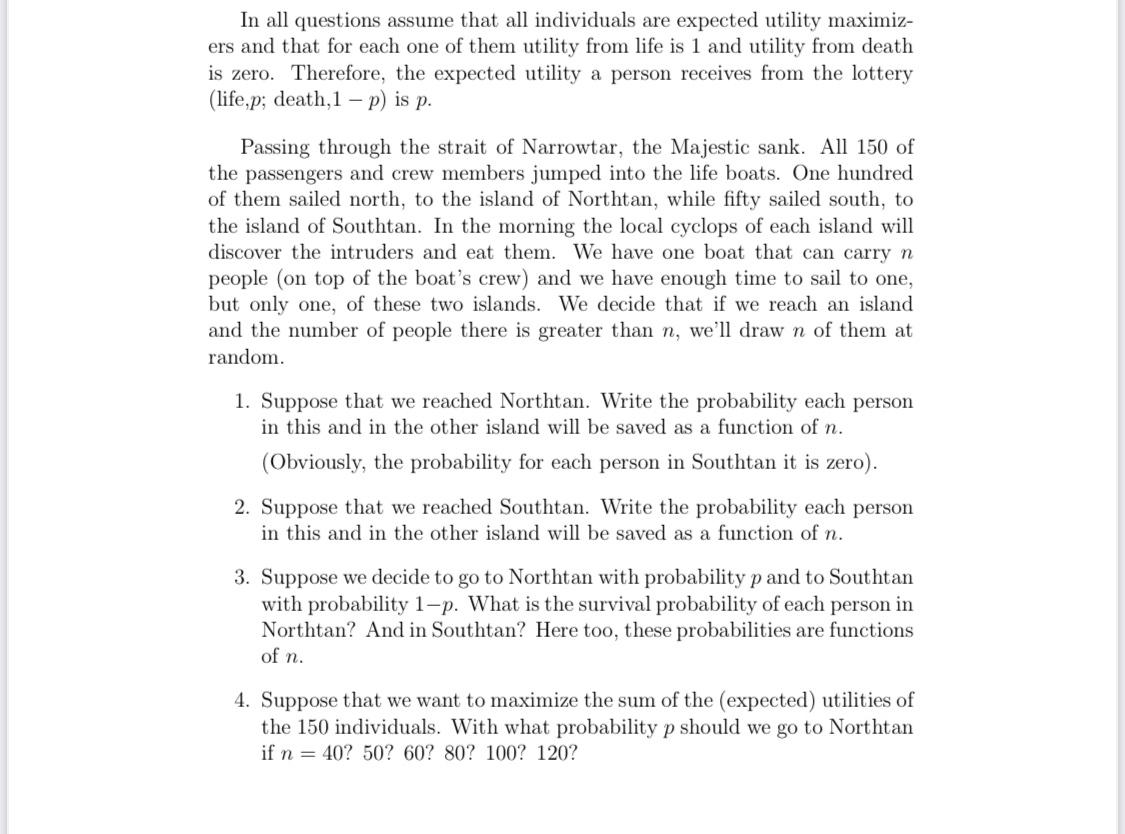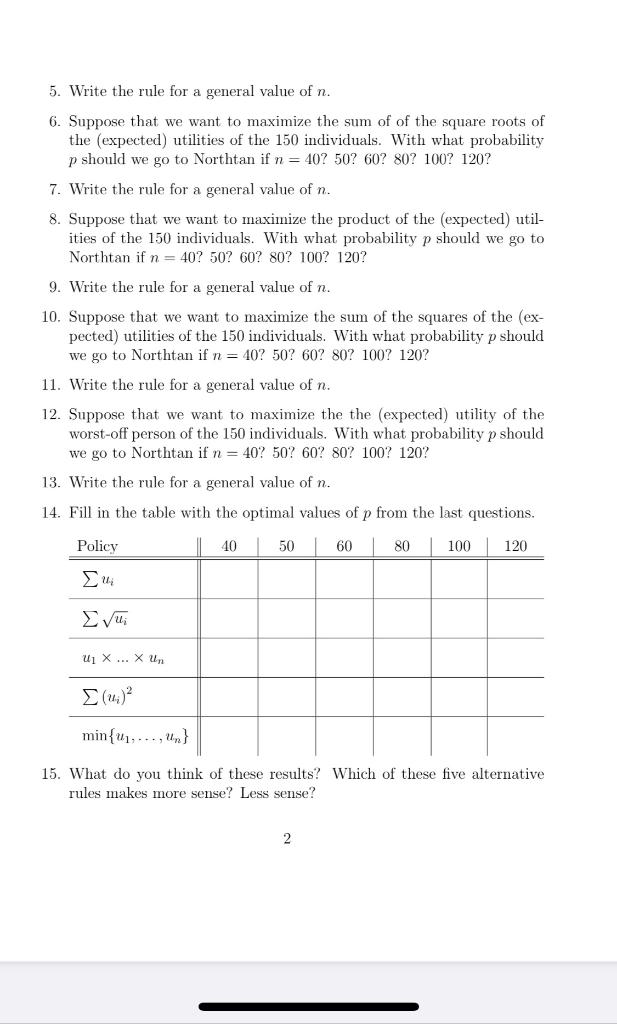
 l
l
In all questions assume that all individuals are expected utility maximiz- ers and that for each one of them utility from life is 1 and utility from death is zero. Therefore, the expected utility a person receives from the lottery (life,p; death, 1 - p) is p. Passing through the strait of Narrowtar, the Majestic sank. All 150 of the passengers and crew members jumped into the life boats. One hundred of them sailed north, to the island of Northtan, while fifty sailed south, to the island of Southtan. In the morning the local cyclops of each island will discover the intruders and eat them. We have one boat that can carry n people (on top of the boat's crew) and we have enough time to sail to one, but only one, of these two islands. We decide that if we reach an island and the number of people there is greater than n, we'll draw n of them at random. 1. Suppose that we reached Northtan. Write the probability each person in this and in the other island will be saved as a function of n. (Obviously, the probability for each person in Southtan it is zero). 2. Suppose that we reached Southtan. Write the probability each person in this and in the other island will be saved as a function of n. 3. Suppose we decide to go to Northtan with probability p and to Southtan with probability 1-p. What is the survival probability of each person in Northtan? And in Southtan? Here too, these probabilities are functions of n. 4. Suppose that we want to maximize the sum of the expected) utilities of the 150 individuals. With what probability p should we go to Northtan if n = 40? 50? 60? 80? 100? 120? 5. Write the rule for a general value of n. 6. Suppose that we want to maximize the sum of of the square roots of the expected) utilities of the 150 individuals. With what probability p should we go to Northtan if n = 402 502 607 80? 100? 120? 7. Write the rule for a general value of n. 8. Suppose that we want to maximize the product of the expected) util- ities of the 150 individuals. With what probability p should we go to Northtan if n = 402 502 607 80? 100? 120? 9. Write the rule for a general value of n. 10. Suppose that we want to maximize the sum of the squares of the (ex- pected) utilities of the 150 individuals. With what probability p should we go to Northtan if n = 402 507 602 80? 1007 120? 11. Write the rule for a general value of n. 12. Suppose that we want to maximize the the expected) utility of the worst-off person of the 150 individuals. With what probability p should we go to Northtan if n = 402 502 602 80? 100? 120? 13. Write the rule for a general value of n. 14. Fill in the table with the optimal values of p from the last questions. Policy 10 50 60 80 100 120 , Vui UiX ... X un (u) min{1,...,Un} 15. What do you think of these results? Which of these five alternative rules makes more sense? Less sense? 2 In all questions assume that all individuals are expected utility maximiz- ers and that for each one of them utility from life is 1 and utility from death is zero. Therefore, the expected utility a person receives from the lottery (life,p; death, 1 - p) is p. Passing through the strait of Narrowtar, the Majestic sank. All 150 of the passengers and crew members jumped into the life boats. One hundred of them sailed north, to the island of Northtan, while fifty sailed south, to the island of Southtan. In the morning the local cyclops of each island will discover the intruders and eat them. We have one boat that can carry n people (on top of the boat's crew) and we have enough time to sail to one, but only one, of these two islands. We decide that if we reach an island and the number of people there is greater than n, we'll draw n of them at random. 1. Suppose that we reached Northtan. Write the probability each person in this and in the other island will be saved as a function of n. (Obviously, the probability for each person in Southtan it is zero). 2. Suppose that we reached Southtan. Write the probability each person in this and in the other island will be saved as a function of n. 3. Suppose we decide to go to Northtan with probability p and to Southtan with probability 1-p. What is the survival probability of each person in Northtan? And in Southtan? Here too, these probabilities are functions of n. 4. Suppose that we want to maximize the sum of the expected) utilities of the 150 individuals. With what probability p should we go to Northtan if n = 40? 50? 60? 80? 100? 120? 5. Write the rule for a general value of n. 6. Suppose that we want to maximize the sum of of the square roots of the expected) utilities of the 150 individuals. With what probability p should we go to Northtan if n = 402 502 607 80? 100? 120? 7. Write the rule for a general value of n. 8. Suppose that we want to maximize the product of the expected) util- ities of the 150 individuals. With what probability p should we go to Northtan if n = 402 502 607 80? 100? 120? 9. Write the rule for a general value of n. 10. Suppose that we want to maximize the sum of the squares of the (ex- pected) utilities of the 150 individuals. With what probability p should we go to Northtan if n = 402 507 602 80? 1007 120? 11. Write the rule for a general value of n. 12. Suppose that we want to maximize the the expected) utility of the worst-off person of the 150 individuals. With what probability p should we go to Northtan if n = 402 502 602 80? 100? 120? 13. Write the rule for a general value of n. 14. Fill in the table with the optimal values of p from the last questions. Policy 10 50 60 80 100 120 , Vui UiX ... X un (u) min{1,...,Un} 15. What do you think of these results? Which of these five alternative rules makes more sense? Less sense? 2

 l
l





